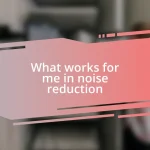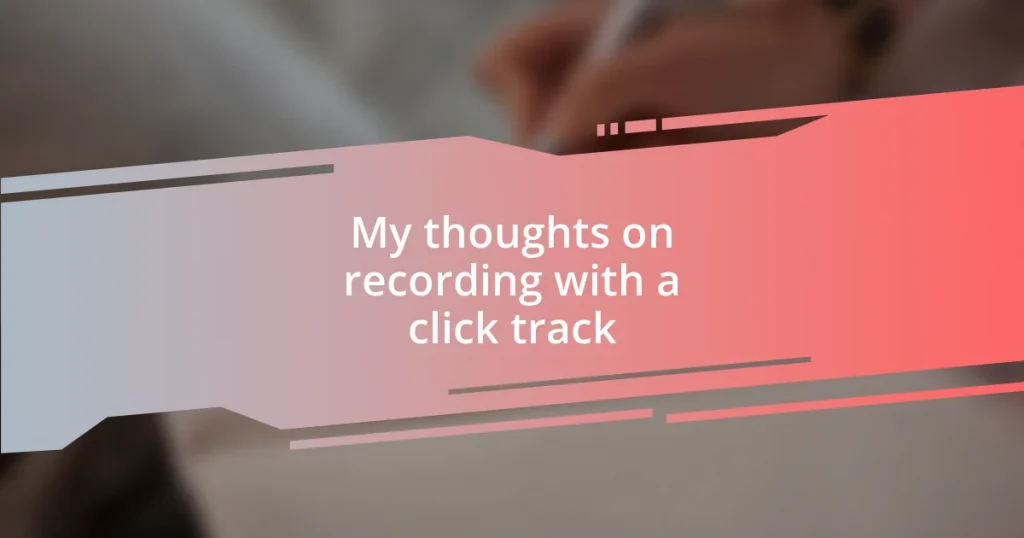Key takeaways:
- Click tracks act as a metronome, providing a steady pulse that enhances rhythmic cohesion and allows musicians to record parts separately without losing timing.
- Practicing with a click track improves timing skills, leads to better editing precision, and fosters a more disciplined recording environment.
- Utilizing click tracks can enhance creativity by encouraging experimentation and collaboration, allowing musicians to explore new ideas within a structured rhythm.

Understanding Click Track Basics
Understanding click tracks is essential for any musician looking to streamline their recording process. A click track acts like a metronome, providing a steady pulse that keeps everything in time. I remember the first time I used one; it felt like a safety net, allowing me to focus on my performance instead of worrying about tempo.
With a click track, musicians can record their parts separately while maintaining the same rhythmic cohesion. This is invaluable in multi-track recording sessions, where layering instruments can otherwise become chaotic. Have you ever felt lost in a mix that seemed to lack direction? Trust me, a solid click track can anchor your performance, bringing clarity and structure.
Of course, adapting to a click track can be a challenge. It may take time to train your ears and internalize that steady beat. I recall struggling through my initial sessions, feeling as if I was fighting against the click. But over time, I learned to embrace it, finding that it ultimately enhanced my timing and overall sound. Isn’t it fascinating how something so simple can redefine our approach to music?

Benefits of Using Click Tracks
Using a click track transforms the studio experience, bringing a level of discipline that I find incredibly beneficial. It helps every musician align their individual performances seamlessly, creating a unified sound that is often hard to achieve otherwise. I remember a jam session where we recorded without a click, and it turned into a messy mix of tempos. When we tried again with a click, everything fell into place, and it felt like magic.
Another advantage of using a click track is the ability to edit with precision. When the timing is consistent, you can easily slice and dice takes, knowing they’ll fit together like puzzle pieces. I once edited a project where every track was recorded to a click; not only did it save time, but it also allowed me to experiment with different arrangements without worrying about drifting tempos.
Lastly, the practice benefits of recording with a click track can’t be underestimated. It challenges musicians to strengthen their timing skills, which is crucial as a performer. I’ve noticed a significant improvement in my groove since consistently using one in the studio. It’s almost like having a trustworthy drummer always supporting you, and I can’t emphasize enough how that enhances the entire production experience.
| Benefit | Description |
|---|---|
| Timing Consistency | Provides a steady pulse for all musicians, enhancing rhythmic cohesion. |
| Editing Precision | Makes it easier to edit between different takes and layers, leading to a polished final product. |
| Practice Enhancement | Helps musicians improve their timing skills and overall performance quality. |

Preparing for Recording Sessions
Preparing for a recording session with a click track involves a unique blend of mental and physical preparation. I always find it helpful to visualize the session in my mind before stepping into the studio. It’s like rehearsing for a play; you want everything to run smoothly. I recall a time when I neglected this preparation and felt scattered during the recording. It resulted in many retakes and frustrations that could have been avoided.
Here are some tips I’ve learned for preparing effectively:
- Set Goals: Determine what you want to achieve during the session.
- Practice with the Click: Spend some time rehearsing with the click track to get comfortable with its tempo.
- Check Your Gear: Ensure your instruments and recording equipment are in good shape before the session.
- Warm Up: Warm up your voice or instrument to set the tone for the session.
- Stay Hydrated: Keep water nearby; staying hydrated can aid in performance clarity.
Taking these steps not only eliminates unnecessary stress but also allows me to focus entirely on my playing. The sense of clarity that comes with being adequately prepared can’t be overstated. For me, it’s all about entering the studio with confidence so that I can really express myself through my music.

Techniques for Staying in Time
When it comes to staying in time with a click track, one technique I’ve found incredibly effective is to subdivide the beats mentally. Imagine breaking each beat into smaller increments, like eighth or sixteenth notes. This approach helped me during a particularly tricky recording session where the tempo felt overwhelming. By focusing on those smaller subdivisions, I felt more in control, as if I was dancing to the rhythm rather than just playing notes.
Another method is to tap into your body’s natural rhythm. I often find myself swaying or tapping my foot in sync with the click. This physical connection makes it easier to internalize the tempo. There was a moment when I lost the groove while recording vocals. By simply allowing my body to move with the click, I rediscovered that connection and locked into the beat more securely. Have you ever noticed how certain movements can enhance your sense of timing?
Lastly, I recommend practicing with backing tracks or metronomes designed for your specific style. Once, I spent time with a funk backing track at varying BPMs. It was illuminating to see how much my timing improved as I adapted my playing to fit the live feel while still respecting the click. Incorporating these techniques not only refines your timing but also unleashes your musicality in new and exciting ways.

Overcoming Common Challenges
Overcoming challenges while recording with a click track often involves adjusting your mindset. I remember a session where my initial anxiety about staying in sync led to a stiff performance. It was a lightbulb moment when I realized that treating the click not as a constraint but as a guide helped me relax. Have you ever felt that that extra pressure could hinder your creativity? When I shifted my perspective, I found a natural flow that allowed the music to breathe.
Another hurdle many face is timing inconsistencies, which can be frustrating. In my experience, using visual cues can bridge that gap. During one recording, I set up a video monitor displaying a bouncing ball synchronized with the click. This simple adjustment transformed the session; I became more aware of my timing without the internal stress of merely listening. Have you tried visualizing your rhythm that way? It can make a world of difference.
Lastly, it’s essential to acknowledge that mistakes happen, and that’s part of the process. I recall a take where I completely lost the beat. Instead of getting upset, I embraced it, laughter mixed with a bit of embarrassment. We ended up capturing some genuine moments afterwards that made it onto the final track. How do you handle those moments? Remember, sometimes the best performances are born from imperfection.

Tips for Effective Practice
When practicing with a click track, I can’t overstate the importance of consistent warm-ups. I’ve had sessions where I dove straight into recording without any preparation, only to realize my timing suffered as a result. I always take at least ten minutes to do simple rhythm exercises. This not only gets my fingers moving but mentally primes me for the task ahead. Have you ever noticed how a bit of practice can transform your playing before hitting the record button?
Another effective tip is to record yourself during practice sessions. I remember the first time I played back my performance only to hear a timing issue I hadn’t noticed before. It was eye-opening! Listening to yourself can reveal so much, from subtle timing nuances to areas needing improvement. It’s like having a personal coach—one you can pause and rewind. Have you tried this approach? The insights can be invaluable.
Finally, setting achievable goals for your practice can make a significant difference. Early in my career, I found myself overwhelmed by the idea of perfecting an entire song in one session. Now, I focus on small sections, dedicating time to master each snippet with the click track before moving on. This method not only boosts my confidence but also provides clarity and progress. What specific sections do you find most challenging? Taking it one step at a time can really transform your practice sessions into productive and fulfilling experiences.

Enhancing Creativity with Click Tracks
Utilizing a click track can be a game changer for enhancing creativity. I recall a particular session where I had a complete breakthrough when I allowed the click to guide me rather than restrict me. Instead of fighting the rhythm, I found myself experimenting with syncopation and trying unexpected accents, which added layers to the project. Have you ever felt liberated by a structured approach, allowing your creativity to flourish within boundaries?
One of the most rewarding aspects of using a click track is the unexpected musical ideas that can emerge during recording. During one session, I remember getting lost in a groove, riffing on a melody inspired by the click. It was as if the rhythmic metronome sparked my imagination, leading me to create something I wouldn’t have thought of otherwise. Have you experienced moments where a steady pulse ignited your creative process? That structured rhythm can serve as a canvas for spontaneous musical expressions.
Finally, I often find that recording with a click track encourages collaboration in unique ways. I experienced this firsthand when working with a fellow musician. We would bounce ideas off each other while staying locked in with the track, leading to fantastic musical conversations. It’s fascinating how a simple tool can allow for deeper interaction and exploration. How do you think a click track could inspire your collaborations? When embraced, it can develop synergy that elevates the overall creativity of the project.













